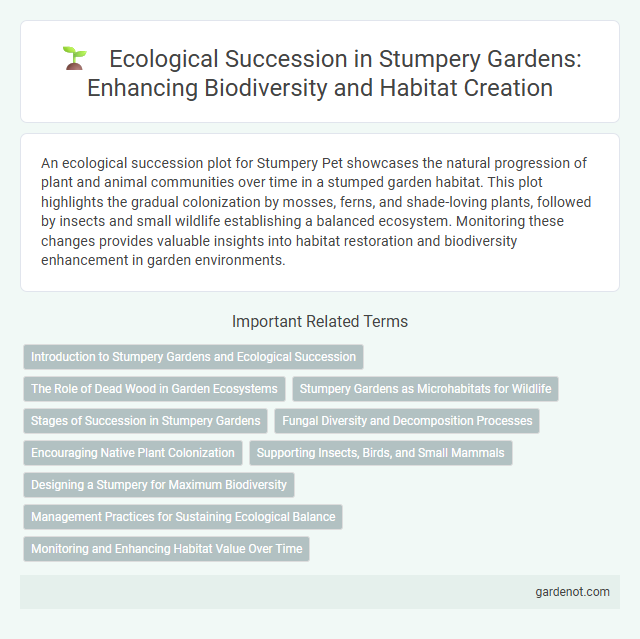An ecological succession plot for Stumpery Pet showcases the natural progression of plant and animal communities over time in a stumped garden habitat. This plot highlights the gradual colonization by mosses, ferns, and shade-loving plants, followed by insects and small wildlife establishing a balanced ecosystem. Monitoring these changes provides valuable insights into habitat restoration and biodiversity enhancement in garden environments.
Introduction to Stumpery Gardens and Ecological Succession
Stumpery gardens showcase a unique form of ecological succession by utilizing decaying tree stumps and logs to create habitats that support diverse fungi, mosses, and invertebrates. These structures accelerate nutrient cycling and foster micro-ecosystems, promoting natural regeneration and biodiversity in woodland environments. By mimicking natural decomposition processes, stumperies exemplify sustainable garden design integrated with ecological restoration principles.
The Role of Dead Wood in Garden Ecosystems
Dead wood in stumperies plays a crucial role in ecological succession by providing habitat and nourishment for fungi, insects, and microorganisms that drive nutrient cycling and soil formation. This decomposition process supports diverse plant species by enriching the soil, promoting seedling establishment, and enhancing overall garden biodiversity. Integrating dead wood into garden ecosystems fosters a resilient environment that mimics natural forest succession stages.
Stumpery Gardens as Microhabitats for Wildlife
Stumpery gardens serve as unique ecological succession plots by creating diverse microhabitats that support a variety of wildlife species, including insects, fungi, and small mammals. The decaying wood structures provide essential resources such as shelter, breeding grounds, and food sources, promoting biodiversity and ecological stability within garden ecosystems. These microhabitats facilitate natural processes of succession by encouraging colonization of pioneer species, enhancing soil health, and supporting a dynamic progression of flora and fauna over time.
Stages of Succession in Stumpery Gardens
Stumpery gardens exhibit distinct stages of ecological succession starting with pioneer species such as mosses and lichens colonizing decomposed wood and shaded soil. These early colonizers facilitate the establishment of ferns, shade-tolerant shrubs, and shade-loving perennials that thrive in the humid, sheltered microenvironment created by stumps and logs. Over time, the stumpery matures into a complex, biodiverse habitat supporting fungi, invertebrates, and woodland plants, reflecting advanced succession stages typical of temperate forest understories.
Fungal Diversity and Decomposition Processes
Stumperies create ideal conditions for fungal diversity by providing decaying wood that supports various saprophytic fungi essential in ecological succession plots. These fungi accelerate decomposition processes, breaking down complex organic matter into simpler nutrients that enrich forest soil. The enhanced fungal activity fosters nutrient cycling and facilitates the gradual replacement of pioneer species by more complex vegetation communities.
Encouraging Native Plant Colonization
Ecological succession in a stumpery promotes encouraging native plant colonization by providing a natural habitat with decaying wood that retains moisture and nutrients essential for seed germination. This environment supports mosses, ferns, and shade-tolerant wildflowers, accelerating the establishment of indigenous flora. Creating such microhabitats enhances biodiversity and fosters ecosystem resilience through natural regeneration processes.
Supporting Insects, Birds, and Small Mammals
A stumpery designed as an ecological succession plot creates a layered habitat rich in decomposing wood, supporting diverse insects such as beetles and woodlice that thrive on decaying matter. This microhabitat attracts insectivorous birds like wrens and robins, which use the dense cover for nesting and foraging. Small mammals, including hedgehogs and shrews, benefit from the shelter and abundant food resources within the stumpery, enhancing local biodiversity and ecosystem health.
Designing a Stumpery for Maximum Biodiversity
Designing a stumpery for maximum biodiversity involves selecting diverse native tree stumps and logs to create microhabitats that support various fungi, invertebrates, and moss species. Integrating piles of decomposing wood at different decay stages accelerates ecological succession, promoting robust soil microbiomes and attracting amphibians and birds. Positioning stumpery elements in shaded, moist areas enhances moisture retention, fostering a rich and resilient ecosystem over time.
Management Practices for Sustaining Ecological Balance
Management practices in stumpery ecological succession plots prioritize maintaining native plant species diversity and promoting natural decomposition processes through minimal disturbance techniques. Regular monitoring of soil moisture, nutrient levels, and invasive species presence supports adaptive interventions that enhance habitat stability. Integration of deadwood retention strategies fosters microhabitat complexity, benefiting fungi, invertebrates, and overall ecosystem resilience.
Monitoring and Enhancing Habitat Value Over Time
Monitoring ecological succession in stumpery plots involves tracking species composition changes and soil development to assess habitat complexity and biodiversity enhancement. Enhancing habitat value requires introducing native plants and fungi that support local wildlife and improving structural diversity by varying log sizes and decay stages. This dynamic management fosters a resilient ecosystem, promoting long-term ecological stability and increased habitat niches.
Ecological succession plot Infographic

 gardenot.com
gardenot.com